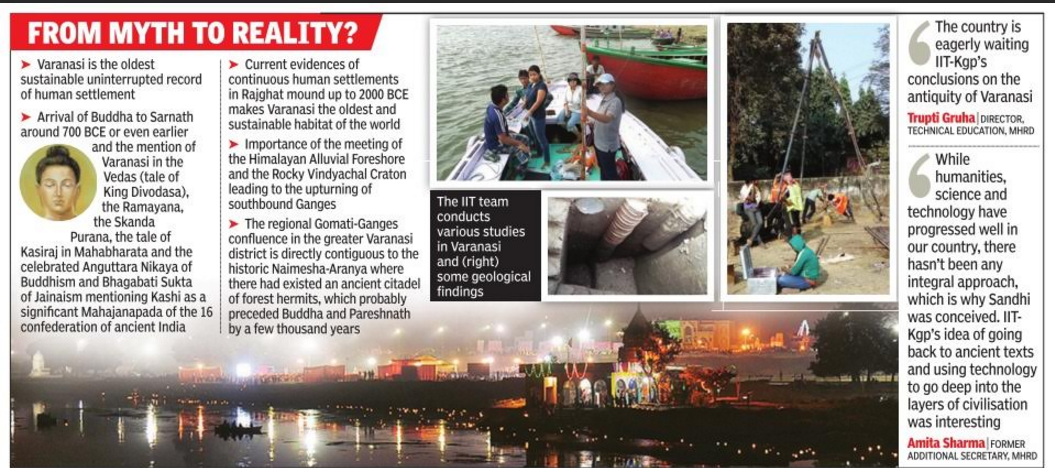Varanasi is as old as Indus valley civilization, finds IIT-KGP study: Times of India
This is a pivotal discovery for Hinduism. It should clearly expose the myth of the Aryan Invasion created by colonial historians to support their own blood thirsty conquest of India. Science is confirming what tradition has held that Varanasi was the first urban human settlement in the world.
The results that have come from a detailed geo exploration through the GPS conducted through 100 metre deep bore holes all over Varanasi shows continuous settlement history till 2000 BC. The indicators are that at the end of data collection, this will be put back another ‘1500 years to establish the final habitable antiquity of Varanasi at 4500 BC. “We are encountering surprises every day. What was thought to be lore or myth is gradually getting established as history, and that is our biggest achievement,” Sen said.
Kolkata: It’s a perfect example of science meeting faith and technology buttressing myth. A detailed study conducted by IIT-Kharagpur – using GPS, one of the latest tech tools – could well turn the clock back on Varanasi, indicating that the holy town has been a continuous human settlement since the days of the Indus Valley Civilization, around 6000 years ago.
The project, funded by the Union ministry of human resources development (it has released Rs 20 crore just for the first phase), has even attracted the attention of Prime Minister Narendra Modi. The PM made it a point to explore the project’s progress on Sunday at Varanasi, when he met the IIT-Kgp faculty members and inquired about its possibilities and scope.
The results that have come from a detailed geo-exploration (exploration conducted through GPS technology) conducted by seven IIT-Kgp departments, tracing the different stages through which civilization progressed, and how Varanasi has been able to maintain continuity as a living civilization, unlike comparable seats of human settlement in the world. The researchers have dug 100-metre-deep boring holes all over Varanasi to conclude that there is evidence of continuous settlement at least till 2000BC. There are enough indications that by the time the data collection is over, there would be enough to prove that this date can be pushed back to about 4500BC.
The oldest part of this civilisation has been traced to the Gomati Sangam area of Varanasi, as indicated by the underground layers that have already been tested.
It is perhaps time to take a re-look at India’s history. IIT Kharagpur is about to make an explosive announcement. It is ready to put the clock 6000 years back on Varanasi, bringing it at par with the Indus valley civilisation, if not older. What’s more, the seven departments of IIT Kgp, that are working on the project, are tracing the different stages through which the civilisation has progressed and has yet been able to maintain its continuity as a living civilisation, unlike comparable ancient civilisations around the world.

The results that have come from a detailed geo exploration through the GPS conducted through 100 metre deep bore holes all over Varanasi shows continuous settlement history till 2000 BC. The indicators are that at the end of data collection, this will be put back another ‘1500 years to establish the final habitable antiquity of Varanasi at 4500 BC.
The geo-exploration, that is being conducted jointly with the British Geological Survey, has already established the existence of Naimisharanya, a forest that finds mention in the Vedas and in the Kashipurana. This forest was considered mythological all these years.
The researchers are also trying to set up a riverine route from Kolkata to Varanasi to Prayag (Allahabad). “Since ancient times, people used this route but the advent of the railways stopped it. We are trying to re-establish that route,” said Joy Sen, a senior faculty member of the school of architecture and planning, who is also the chief of the project that has been christened Sandhi. The other departments that are involved in sandhi are humanities and social sciences, computer science, information technology, electrical, electronics and telecommunications and oceanography. The riverine route will be developed to carry tourists, said sources.
Separate heritage trails leading to the five oldest ghats – Asi, Kedar, Dasashwamedh, Panchaganga and Rajghat – are also being created. “We are tracing the ashrams of ancient yogis and spiritual leaders of all religions that dotted the lanes leading to the ghats. Some of these are extinct now, some dilapidated. We will reclaim and restore as much as possible,” Sen explained.
A large part of the project, which began in August last year, aims at creating a green rim and reclaiming the greenery and waterbodies that dotted the entire zone from Sarnath to the campus of Benares Hindu University. Efforts are on to remove encroachment and illegal constructions so that the earlier ecosystem is reclaimed as far as possible. “Varanasi has been the seat of all religions and their holy men, who will all be represented elaborately in the project. Efforts are also being made to establish special zones in areas that are dominated by old age homes and shelters for widows,” Sen added.
Language, music and iconograohy play a major role in Sandhi. Old texts like Kashipuran or Skandapuran, Mahabharata and Ramayana and the Buddhist text Anguttaranikaya are being re-read for descriptions of Kashi and Kashiraj that were considered mythological all these years.







